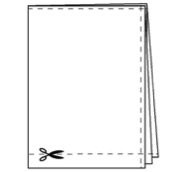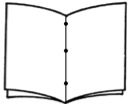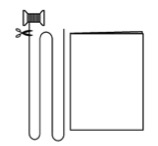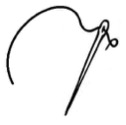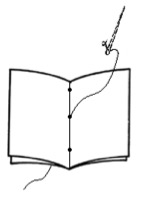Dear Diary,
Oh, I mean…Dear Nimra,
Making a diary is like creating your own top-secret book. So, I headed straight for a Washington State University library where there are more than a million books.
My friend Linnea Nelson was working with some of the books from the special collections when I went to visit her in the lab. She is a conservator, so part of her job is to repair and re-build old books. It preserves their history.
Some of the books had an old smell that wafted up into my little nose. The smell comes from different chemical compounds that escape into the air, including one similar to vanilla. The compounds are in the ink, paper, and other materials used to keep the pages together. And one way to keep the pages together is to bind them with thread.
People have bound, or sewn, books together for thousands of years. Before humans even discovered how to make paper out of tree pulp, people in Asia used twine string to bind palm tree leaves. Then they wrote on the leaves with ink.
If you’re up for the challenge of binding a diary together, you’ll need paper, thread, a needle, and scissors. Since it can be tricky to sew with paws, Nelson showed me how to bind a booklet. You may want to ask a grown-up for some help, too. You can find all the instructions below.
Once you have a place to write, the next step is to decide what to write, said my friend Trevor Bond, a rare book librarian at the WSU Libraries.
“The really best diaries share people’s emotions and feelings about events,” Bond said. “They also personalize history in interesting ways.”
A lot of people start diary entries by writing the date at the top of the page. That way when they are older, they can look back at their own history. Historians can use information from old diaries to discover “glimmers of information” about different time periods, Bond explained.
One of the most famous diaries is Anne Frank’s. We have copies of the diary here at the WSU library, but the original is at the Anne Frank House, a museum in Amsterdam. Anne lived in hiding from the Nazis during World War II and after the war her father published her journal. When she started her diary she wrote: “For someone like me, it is a very strange habit to write in a diary. Not only that I have never written before, but it strikes me that later neither I, nor anyone else, will care for the outpouring of a thirteen year old schoolgirl.”
Now, lots of students around the world read the historic diary in school. Anne’s diary had a plaid, red cloth cover. Technically it was an autograph book, but as long as you write in it regularly, a diary can really be anything you wish.
Anne’s diary also had a lock. Bond said if you want to keep your diary top-secret, the last step is to get a lock—or just make sure to find your diary a really good hiding spot.
Sincerely,
Dr. Universe
| 12. Cut off the extra thread |  |
| 13. Enjoy your booklet. |  |

